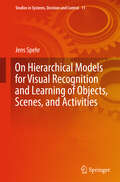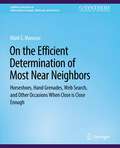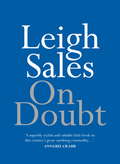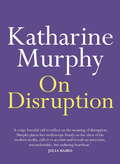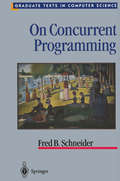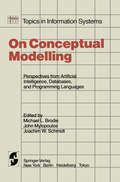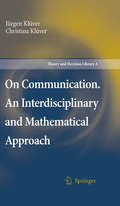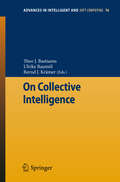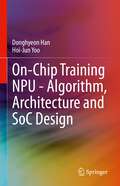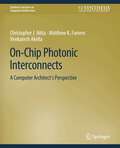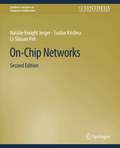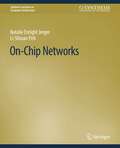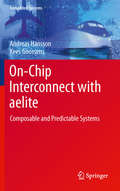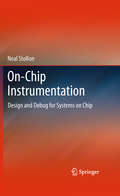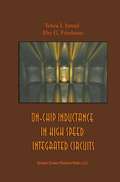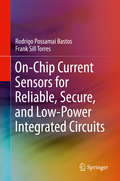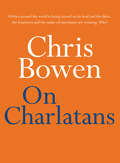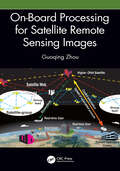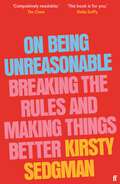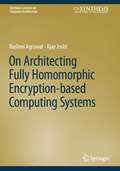- Table View
- List View
On Hierarchical Models for Visual Recognition and Learning of Objects, Scenes, and Activities (Studies in Systems, Decision and Control #11)
by Jens SpehrIn many computer vision applications, objects have to be learned and recognized in images or image sequences. This book presents new probabilistic hierarchical models that allow an efficient representation of multiple objects of different categories, scales, rotations, and views. The idea is to exploit similarities between objects and object parts in order to share calculations and avoid redundant information. Furthermore inference approaches for fast and robust detection are presented. These new approaches combine the idea of compositional and similarity hierarchies and overcome limitations of previous methods. Besides classical object recognition the book shows the use for detection of human poses in a project for gait analysis. The use of activity detection is presented for the design of environments for ageing, to identify activities and behavior patterns in smart homes. In a presented project for parking spot detection using an intelligent vehicle, the proposed approaches are used to hierarchically model the environment of the vehicle for an efficient and robust interpretation of the scene in real-time.
On The Efficient Determination of Most Near Neighbors (Synthesis Lectures on Information Concepts, Retrieval, and Services)
by Mark ManasseThe time-worn aphorism "close only counts in horseshoes and hand-grenades" is clearly inadequate. Close also counts in golf, shuffleboard, archery, darts, curling, and other games of accuracy in which hitting the precise center of the target isn't to be expected every time, or in which we can expect to be driven from the target by skilled opponents. This lecture is not devoted to sports discussions, but to efficient algorithms for determining pairs of closely related web pages -- and a few other situations in which we have found that inexact matching is good enough; where proximity suffices. We will not, however, attempt to be comprehensive in the investigation of probabilistic algorithms, approximation algorithms, or even techniques for organizing the discovery of nearest neighbors. We are more concerned with finding nearby neighbors; if they are not particularly close by, we are not particularly interested. In thinking of when approximation is sufficient, remember the oft-told joke about two campers sitting around after dinner. They hear noises coming towards them. One of them reaches for a pair of running shoes, and starts to don them. The second then notes that even with running shoes, they cannot hope to outrun a bear, to which the first notes that most likely the bear will be satiated after catching the slower of them. We seek problems in which we don't need to be faster than the bear, just faster than the others fleeing the bear.
On Doubt (On Series)
by Leigh SalesAcclaimed journalist Leigh Sales has her doubts, and thinks you should, too.Her classic personal essay carries a message of truth, scrutiny and accountability-a much-needed pocket-sized antidote to fake news.Donald Trump, the post-truth world and the instability of Australian politics are all examined in this fresh take on her prescient essay on the media and political trends that define our times.
On Disruption (On Series)
by Katharine MurphyThe internet has shaken the foundations of life: public and private lives are wrought by the 24-hour, seven-day-a-week news cycle that means no one is ever off duty. On Disruption is a report from the coalface of that change: what has happened, will it keep happening, and is there any way out of the chaos?
On Concurrent Programming (Texts in Computer Science)
by Fred B. SchneiderHere, one of the leading figures in the field provides a comprehensive survey of the subject, beginning with prepositional logic and concluding with concurrent programming. It is based on graduate courses taught at Cornell University and is designed for use as a graduate text. Professor Schneier emphasises the use of formal methods and assertional reasoning using notation and paradigms drawn from programming to drive the exposition, while exercises at the end of each chapter extend and illustrate the main themes covered. As a result, all those interested in studying concurrent computing will find this an invaluable approach to the subject.
On Conceptual Modelling: Perspectives from Artificial Intelligence, Databases, and Programming Languages (Topics in Information Systems)
by M. L. Brodie J. Mylopoulos J. W. SchmidtThe growing demand for systems of ever-increasing complexity and precision has stimulated the need for higher level concepts, tools, and techniques in every area of Computer Science. Some of these areas, in particular Artificial Intelligence, Databases, and Programming Lan guages, are attempting to meet this demand by defining a new, more abstract level of system description. We call this new level conceptual in recognition of its basic conceptual nature. In Artificial Intelligence, the problem of designing an expert system is seen primarily as a problem of building a knowledge base that repre sents knowledge about an enterprise. Consequently, Knowledge Repre sentation is viewed as a central issue in Artificial Intelligence research. Database design methodologies developed during the last five years are almost unanimous in offering semantic data models in terms of which the designer directly and naturally models an enterprise before proceed ing to a detailed logical and physical database design. In Programming Languages, different forms of abstraction which allow implementation independent specifications of data, functions, and control have been a major research theme for a decade. To emphasize the common goals of these three research efforts, we call this new activity conceptual modelling.
On Communication. An Interdisciplinary and Mathematical Approach (Theory and Decision Library A: #40)
by Jürgen Klüver Christina KlüverThis book offers a radical new theoretical approach for the understanding of communication. The theory is operationalized by the application of certain computer programs, namely Soft Computing programs like cellular automata and artificial neural nets. In many examples the authors demonstrate how it is possible to model and analyze communicative processes, such as social combined with cognitive ones.
On Collective Intelligence (Advances in Intelligent and Soft Computing #76)
by Theo J. Bastiaens Ulrike Baumöl Bernd KrämerWelcome to the proceedings of the inaugural Symposium on Collective Intelligence (COLLIN 2010). This was the first of a new series of events that will evolve over the coming years, and we were happy to hold the event in Hagen where the idea for this symposium was born. The participants visited Hagen in April, with excellent opportunities to get rain, wind and sun. Collective intelligence denotes a phenomenon according to which the purposeful interaction between individuals creates intelligent solutions and behaviors that might not have come to existence without this concerted effort of a community. The members of such communities form a social network, typically over the Internet. They are engage with each other over a sustained period of time to develop an area of innovation through collaboration and exchange of ideas, experiences and information. Leading-edge information and communication technologies (ICT) offer ample opportunities for enabling collective intelligence. COLLIN aims to become the flagship conference in the areas collective intelligence and ICT-enabled social networking, which is attracting more and more researchers and practitioners from both academia and industry.
On-Chip Training NPU - Algorithm, Architecture and SoC Design
by Donghyeon Han Hoi-Jun YooUnlike most available sources that focus on deep neural network (DNN) inference, this book provides readers with a single-source reference on the needs, requirements, and challenges involved with on-device, DNN training semiconductor and SoC design. The authors include coverage of the trends and history surrounding the development of on-device DNN training, as well as on-device training semiconductors and SoC design examples to facilitate understanding.
On-Chip Photonic Interconnects: A Computer Architect's Perspective (Synthesis Lectures on Computer Architecture)
by Christopher J. Nitta Matthew Farrens Venkatesh AkellaAs the number of cores on a chip continues to climb, architects will need to address both bandwidth and power consumption issues related to the interconnection network. Electrical interconnects are not likely to scale well to a large number of processors for energy efficiency reasons, and the problem is compounded by the fact that there is a fixed total power budget for a die, dictated by the amount of heat that can be dissipated without special (and expensive) cooling and packaging techniques. Thus, there is a need to seek alternatives to electrical signaling for on-chip interconnection applications. Photonics, which has a fundamentally different mechanism of signal propagation, offers the potential to not only overcome the drawbacks of electrical signaling, but also enable the architect to build energy efficient, scalable systems. The purpose of this book is to introduce computer architects to the possibilities and challenges of working with photons and designing on-chip photonic interconnection networks.
On-Chip Networks, Second Edition (Synthesis Lectures on Computer Architecture)
by Natalie Enright Jerger Tushar Krishna Li-Shiuan PehThis book targets engineers and researchers familiar with basic computer architecture concepts who are interested in learning about on-chip networks. This work is designed to be a short synthesis of the most critical concepts in on-chip network design. It is a resource for both understanding on-chip network basics and for providing an overview of state of-the-art research in on-chip networks. We believe that an overview that teaches both fundamental concepts and highlights state-of-the-art designs will be of great value to both graduate students and industry engineers. While not an exhaustive text, we hope to illuminate fundamental concepts for the reader as well as identify trends and gaps in on-chip network research. With the rapid advances in this field, we felt it was timely to update and review the state of the art in this second edition. We introduce two new chapters at the end of the book. We have updated the latest research of the past years throughout the book and also expanded our coverage of fundamental concepts to include several research ideas that have now made their way into products and, in our opinion, should be textbook concepts that all on-chip network practitioners should know. For example, these fundamental concepts include message passing, multicast routing, and bubble flow control schemes.
On-Chip Networks (Synthesis Lectures on Computer Architecture)
by Natalie Enright Li-shiuan PehWith the ability to integrate a large number of cores on a single chip, research into on-chip networks to facilitate communication becomes increasingly important. On-chip networks seek to provide a scalable and high-bandwidth communication substrate for multi-core and many-core architectures. High bandwidth and low latency within the on-chip network must be achieved while fitting within tight area and power budgets. In this lecture, we examine various fundamental aspects of on-chip network design and provide the reader with an overview of the current state-of-the-art research in this field. Table of Contents: Introduction / Interface with System Architecture / Topology / Routing / Flow Control / Router Microarchitecture / Conclusions
On-Chip Interconnect with aelite: Composable and Predictable Systems (Embedded Systems)
by Andreas Hansson Kees GoossensThe book provides a comprehensive description and implementation methodology for the Philips/NXP Aethereal/aelite Network-on-Chip (NoC). The presentation offers a systems perspective, starting from the system requirements and deriving and describing the resulting hardware architectures, embedded software, and accompanying design flow. Readers get an in depth view of the interconnect requirements, not centered only on performance and scalability, but also the multi-faceted, application-driven requirements, in particular composability and predictability. The book shows how these qualitative requirements are implemented in a state-of-the-art on-chip interconnect, and presents the realistic, quantitative costs.
On-Chip Instrumentation: Design and Debug for Systems on Chip
by Neal StollonThis book provides an in-depth overview of on chip instrumentation technologies and various approaches taken in adding instrumentation to System on Chip (ASIC, ASSP, FPGA, etc.) design that are collectively becoming known as Design for Debug (DfD). On chip instruments are hardware based blocks that are added to a design for the specific purpose and improving the visibility of internal or embedded portions of the design (specific instruction flow in a processor, bus transaction in an on chip bus as examples) to improve the analysis or optimization capabilities for a SoC. DfD is the methodology and infrastructure that surrounds the instrumentation. Coverage includes specific design examples and discussion of implementations and DfD tradeoffs in a decision to design or select instrumentation or SoC that include instrumentation. Although the focus will be on hardware implementations, software and tools will be discussed in some detail.
On-Chip Inductance in High Speed Integrated Circuits
by Yehea I. Ismail Eby G. FriedmanThe appropriate interconnect model has changed several times over the past two decades due to the application of aggressive technology scaling. New, more accurate interconnect models are required to manage the changing physical characteristics of integrated circuits. Currently, RC models are used to analyze high resistance nets while capacitive models are used for less resistive interconnect. However, on-chip inductance is becoming more important with integrated circuits operating at higher frequencies, since the inductive impedance is proportional to the frequency. The operating frequencies of integrated circuits have increased dramatically over the past decade and are expected to maintain the same rate of increase over the next decade, approaching 10 GHz by the year 2012. Also, wide wires are frequently encountered in important global nets, such as clock distribution networks and in upper metal layers, and performance requirements are pushing the introduction of new materials for low resistance interconnect, such as copper interconnect already used in many commercial CMOS technologies. On-Chip Inductance in High Speed Integrated Circuits deals with the design and analysis of integrated circuits with a specific focus on on-chip inductance effects. It has been described throughout this book that inductance can have a tangible effect on current high speed integrated circuits. For example, neglecting inductance and using an RC interconnect model in a production 0.25 mum CMOS technology can cause large errors (over 35%) in estimates of the propagation delay of on-chip interconnect. It has also been shown that including inductance in the repeater insertion design process as compared to using an RC model improves the overall repeater solution in terms of area, power, and delay with average savings of 40.8%, 15.6%, and 6.7%, respectively. On-Chip Inductance in High Speed Integrated Circuits is full of design and analysis techniques for RLC interconnect. These techniques are compared to techniques traditionally used for RC interconnect design to emphasize the effect of inductance. On-Chip Inductance in High Speed Integrated Circuits will be of interest to researchers in the area of high frequency interconnect, noise, and high performance integrated circuit design.
On-Chip Current Sensors for Reliable, Secure, and Low-Power Integrated Circuits
by Rodrigo Possamai Bastos Frank Sill TorresThis book provides readers with insight into an alternative approach for enhancing the reliability, security, and low power features of integrated circuit designs, related to transient faults, hardware Trojans, and power consumption. The authors explain how the addition of integrated sensors enables the detection of ionizing particles and how this information can be processed at a high layer. The discussion also includes a variety of applications, such as the detection of hardware Trojans and fault attacks, and how sensors can operate to provide different body bias levels and reduce power costs. Readers can benefit from these sensors-based approaches through designs with fast response time, non-intrusive integration on gate-level and reasonable design costs.
On Charlatans (On Series)
by Chris BowenWhy do we continue to vote for politicians who say 'I don't hold a hose, mate' or who advocate that we drink bleach to fight COVID-19? Chris Bowen, who was set to be Treasurer had Labor won the 2019 federal election, has had plenty of time to think about what went wrong and about why charlatans are winning in the game of politics.For charlatans, the road to political success is paved with dishonesty, disunity, fake news and empty promises. Selling themselves as a new and different alternative to traditional politicians, charlatans have decimated centre-left political parties around the world but offer no solutions to the concerns of the ordinary people who they dupe into voting for them.Between Trump's disastrous final weeks in the White House, the United Kingdom's total COVID-19 meltdown under Boris and the three-word slogans driving Scotty from Marketing's policies, Chris Bowen's dissection of the politics of charlatanism and his stirring call to defeat it has never been more urgent.
On-Board Processing for Satellite Remote Sensing Images
by Guoqing ZhouOn-board image processing systems are used to maximize image data transmission efficiency for large volumes of data gathered by Earth observation satellites. This book explains the methods, mathematical models, and key technologies used for these systems. It introduces the background, basic concepts, and the architecture of on-board image processing, along with on-board detection of the image feature and matching, ground control point identification, on-board geometric correction, calibration, geographic registration, etc. • Describes algorithms and methodologies for on-board image processing with FPGA chips. • Migrates the traditional on-ground computing to on-board operation and the image processing is implemented on-board, not on-ground. • Introduces for the first time many key technologies and methods for on-board image processing. • Emphasizes the recent progress in image processing by using on-board FPGA chips. • Includes case studies from the author’s extensive research and experience on the topic. This book gives insights into emerging technologies for on-board processing and will benefit senior undergraduate and graduate students of remote sensing, information technology, computer science and engineering, electronic engineering, and geography, as well as researchers and professionals interested in satellite remote sensing image processing in academia, and governmental and commercial sectors.
On-Board Processing for Satellite Remote Sensing Images
by Guoqing ZhouOn-board image processing systems are used to maximize image data transmission efficiency for large volumes of data gathered by Earth observation satellites. This book explains the methods, mathematical models, and key technologies used for these systems. It introduces the background, basic concepts, and the architecture of on-board image processing, along with on-board detection of the image feature and matching, ground control point identification, on-board geometric correction, calibration, geographic registration, etc. • Describes algorithms and methodologies for on-board image processing with FPGA chips. • Migrates the traditional on-ground computing to on-board operation and the image processing is implemented on-board, not on-ground. • Introduces for the first time many key technologies and methods for on-board image processing. • Emphasizes the recent progress in image processing by using on-board FPGA chips. • Includes case studies from the author’s extensive research and experience on the topic. This book gives insights into emerging technologies for on-board processing and will benefit senior undergraduate and graduate students of remote sensing, information technology, computer science and engineering, electronic engineering, and geography, as well as researchers and professionals interested in satellite remote sensing image processing in academia, and governmental and commercial sectors.
On Being Unreasonable: Breaking the Rules and Making Things Better
by Kirsty SedgmanManners, order and respect... these are all ideals we subscribe to. In opposed positions, we ought to be able to 'agree to disagree'. Today's world is built from structures of standards and reason, but it is imperative to ask who constructed these norms, and why. We are more divided than ever before-along lines of race, gender, class, disability-and it's time to question who benefits the most. What if our propensity to measure human behaviour against rules and reason is actually more problematic than it might seem? Kirsty Sedgman shows how power dynamics and the social biases involved have resulted in a wide acceptance of what people should and shouldn't do, but they create discriminatory realities and amount to a societal façade that is dangerous for genuine social progress. From taking the knee to breastfeeding in public, from neighbourhood vigilantism to the Colston Four-and exploring ideas around ethics, justice, society, and equality along the way-Sedgman explores notions of civility throughout history up to now.On Being Unreasonable mounts a vital and spirited defence of why and how being unreasonable can help improve the world. It examines and parses the pros and cons of our rules around reason, but leaves us with the rousing question: What if behaving unreasonably at times might be the best way to bring about meaningful change that is long overdue?
On Architecting Fully Homomorphic Encryption-based Computing Systems (Synthesis Lectures on Computer Architecture)
by Rashmi Agrawal Ajay JoshiThis book provides an introduction to the key concepts of Fully Homomorphic Encryption (FHE)-based computing, and discusses the challenges associated with architecting FHE-based computing systems. Readers will see that due to FHE’s ability to compute on encrypted data, it is a promising solution to address privacy concerns arising from cloud-based services commonly used for a variety of applications including healthcare, financial, transportation, and weather forecasting. This book explains the fundamentals of the FHE operations and then presents an architectural analysis of the FHE-based computing. The authors also highlight challenges associated with accelerating FHE on various commodity platforms and argue that the FPGA platform provides a sweet spot in making privacy-preserving computing plausible.
On Animation: The Director's Perspective Vol 1
by Ron DiamondBe a fly on the wall as industry leaders Bill Kroyer and Tom Sito take us through insightful face-to-face interviews, revealing, in these two volumes, the journeys of 23 world-class directors as they candidly share their experiences and personal views on the process of making feature animated films. The interviews were produced and edited by Ron Diamond. Your job is not to be the one with the answers. You should be the one that gets the answers. That’s your job. You need to make friends and get to know your crew. These folks are your talent, your bag of tricks. And that’s where you’re going to find answers to the big problems - Andrew Stanton It’s hard. Yet the pain you go through to get what you need for your film enriches you, and it enriches the film. – Brenda Chapman Frank and Ollie always used to say that great character animation contains movement that is generated by the character’s thought process. It can’t be plain movement. – John Lasseter The beauty of clay is that it doesn’t have to be too polished, or too smooth and sophisticated. You don’t want it to be mechanical and lifeless. – Nick Park The good thing about animation is that tape is very cheap. Let the actor try things. This is where animation gets to play with spontaneity. You want to capture that line as it has never been said before. And, most likely, if you asked the actor to do it again, he or she just can’t repeat that exact performance. But you got it. – Ron Clements
On Animation: The Director's Perspective Vol 2
by Ron DiamondOn Animation: The Director's Perspective is a collection of interviews with 23 animated feature-film directors. These extensive interviews were conducted over the past several years by filmmakers and educators (and peers to the directors interviews) Tom Sito and Bill Kroyer. Interviews cover in-depth discussion of each director's career -- focusing on their creative development, their films, lesson learned and advice. The interviews were edited and produced by Ron Diamond.Key FeaturesInterviews with the greatest living legends in animationOffers profound insight into the creative process of these giantsGrants advice and lessons for inspiring animators
On Animation: The Director's Perspective Vol 1
by Ron DiamondBe a fly on the wall as industry leaders Bill Kroyer and Tom Sito take us through insightful face-to-face interviews, revealing, in these two volumes, the journeys of 23 world-class directors as they candidly share their experiences and personal views on the process of making feature animated films. The interviews were produced and edited by Ron Diamond. Your job is not to be the one with the answers. You should be the one that gets the answers. That’s your job. You need to make friends and get to know your crew. These folks are your talent, your bag of tricks. And that’s where you’re going to find answers to the big problems - Andrew Stanton It’s hard. Yet the pain you go through to get what you need for your film enriches you, and it enriches the film. – Brenda Chapman Frank and Ollie always used to say that great character animation contains movement that is generated by the character’s thought process. It can’t be plain movement. – John Lasseter The beauty of clay is that it doesn’t have to be too polished, or too smooth and sophisticated. You don’t want it to be mechanical and lifeless. – Nick Park The good thing about animation is that tape is very cheap. Let the actor try things. This is where animation gets to play with spontaneity. You want to capture that line as it has never been said before. And, most likely, if you asked the actor to do it again, he or she just can’t repeat that exact performance. But you got it. – Ron Clements
On Animation: The Director's Perspective Vol 2
by Ron DiamondOn Animation: The Director's Perspective is a collection of interviews with 23 animated feature-film directors. These extensive interviews were conducted over the past several years by filmmakers and educators (and peers to the directors interviews) Tom Sito and Bill Kroyer. Interviews cover in-depth discussion of each director's career -- focusing on their creative development, their films, lesson learned and advice. The interviews were edited and produced by Ron Diamond.Key FeaturesInterviews with the greatest living legends in animationOffers profound insight into the creative process of these giantsGrants advice and lessons for inspiring animators
